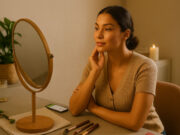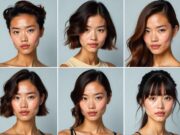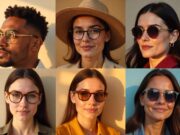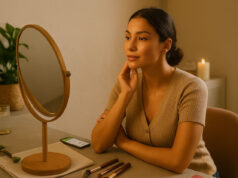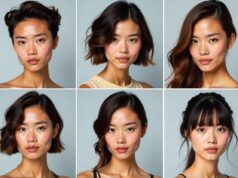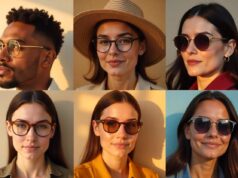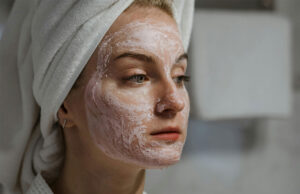Ever tried a hairstyle or pair of glasses that looked amazing on someone else, but just didn’t feel right on you? That’s not just bad luck — it’s likely because of your face shape. And figuring out yours? Game changer.
Face shape influences everything from your haircut and makeup to which sunglasses suit you best. I’ve been there, scrolling through Pinterest and wondering why nothing looked quite right. Once I understood my face shape, everything started to click — from selfies to style confidence.
This guide breaks it all down. We’ll go through each face shape, how to tell which one you’ve got, and how to highlight your natural features instead of fighting them. Ready to meet your face’s best look?
The 7 Common Face Shapes
1. Oval Face Shape
You’ve got slightly wider cheekbones and a face that tapers gently at the chin. Lucky you — oval faces are considered the most versatile.

Style tip: Almost every haircut, hat, or frame flatters you. Want bangs? Go for it. Long layers? Yes. Sharp bob? Also yes.
2. Round Face Shape
Your face is about as wide as it is long, with full cheeks and soft lines. It gives off a youthful, friendly vibe.
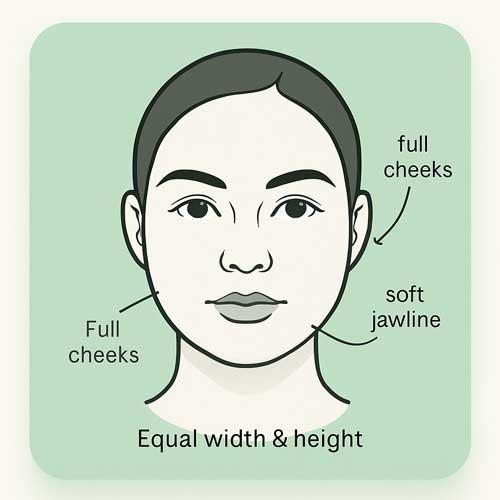
Style tip: Go for volume at the crown or longer lengths to add height and balance. Angular layers and side-swept bangs are your allies.
3. Square Face Shape
Defined by a strong jaw and broad forehead — your face is all about bold angles. Think superhero energy.

Style tip: Soften the corners with textured cuts, curls, or wispy layers. Avoid blunt lines that mimic your jawline.
4. Heart Face Shape
A wider forehead that narrows down to a pointed chin — kind of like an upside-down triangle.

Style tip: Balance the top with volume at the jawline. Think bobs, long side bangs, or waves starting below the cheekbones.
5. Diamond Face Shape
Narrow forehead and jawline with the widest point at your cheekbones. Elegant and edgy at the same time.

Style tip: Soften those angles with face-framing layers. Chin-length bobs and curtain bangs work like magic.
6. Oblong Face Shape
Your face is longer than it is wide, with a straight, narrow look. Think Gisele Bündchen.

Style tip: Add volume on the sides and avoid height at the crown. Waves, curls, and layers break up the length beautifully.
7. Triangle Face Shape
You’ve got a strong, wide jawline and a narrower forehead. This shape flips the classic heart.
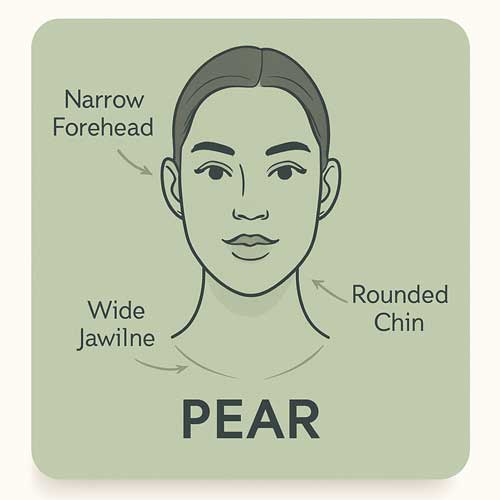
Style tip: Bring balance with layered cuts and volume on top. Avoid chin-length styles that widen the jaw even more.
How to Determine Your Face Shape
You don’t need fancy tools — just a mirror, a selfie, or even a measuring tape. Or You might want to use this face shape detector ai tool.
Step 1: Pull your hair back and take a front-facing photo. No filters, no angles.
Step 2: Measure your forehead (hairline to hairline), cheekbones (across), jawline (edge to chin, then double it), and face length (hairline to chin).
Step 3: Compare these numbers. Is one area dominant? Do the sides of your face curve or angle?
Not into measuring? Trace your face outline in a mirror with a bar of soap or lipstick. Sounds silly, but it works.
Some apps even analyze your selfie for you. But trust your eyes — you know your features best.
The Role of Cheekbones in Face Shapes
Cheekbones do more than hold up blush — they define the angles of your entire face.
There are generally four cheekbone types:
- High & prominent – Sit close to your eyes. Show up strongly in side profiles.
- Low & subtle – Start lower down your face, giving a softer curve.
- Wide-set – Make your face feel more oval or round.
- Narrow-set – Often seen in diamond or oblong faces.
Wondering why some styles look amazing on models but not on you? Cheekbone placement is often the answer. They influence how glasses sit, how shadows fall, and how volume in hair changes your look.
If you’re aiming to play up your cheekbones, add layers or curls that fall right below them. Want to minimize them? Opt for side parts or soft waves that redirect focus.
Styling Tips Based on Face Shape
Here’s a cheat sheet to make your styling choices easier:
- Oval: Try anything. Seriously.
- Round: Add height and angles. Avoid width at cheeks.
- Square: Go soft. Think waves, layers, texture.
- Heart: Fill in around the jawline. Side bangs = win.
- Diamond: Think soft layers and balanced volume.
- Oblong: Width over height. Say yes to curls.
- Triangle: Add lift at the crown. Keep jawline light.
Glasses tip: Round frames soften angular faces. Angular frames add edge to round ones.
Makeup tip: Contour to play with shape, highlight to enhance — but use both sparingly.
Have you ever looked at a style and thought, “Why does this work for her but not for me?” This is why. Face shape changes everything.
Frequently Asked Questions
Yes — weight loss, aging, or bone structure shifts can subtly alter it. But your core shape usually stays consistent.
Not at all. Every face shape is beautiful. It’s all about how you work with what you’ve got.
Seven major ones, but everyone’s unique. You might fall between two.
Totally. The right cut can elongate, narrow, soften, or balance features.
Not really. It’s more about confidence and styling. Every shape can shine on camera.
Final Tip
Before your next hair appointment, try this: grab a lipstick, trace your face in the mirror, and take a selfie. Compare it to a face shape chart. It’s a fun way to figure it out — and you might just unlock a look you’ve never tried but absolutely love.
Your face isn’t a flaw to fix — it’s a canvas to play with. Embrace it.

